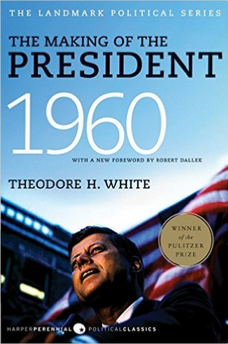Seminal Works of Political Campaign Narrative: Part 1
Adapted from my 2015 Masters Degree Creative Project “Tie-dyed Candidate”
I’ve begun studying the evolution of the long-form narrative style of reporting on political campaigns. My creative project in 2015 for my MA in journalism utilized long-form narrative style in a character study of the Libertarian candidate for Governor of Indiana. Many works of long-form political coverage served as inspiration, or led to other works that I’m studying now (or are on my list for study).
This piece looks at what was probably the first of the modern long-form pieces on presidential politics. Ted White’s work in 1960 and 1964 inspired many others, including Joe McGinnis and Richard Ben Cramer among others. This is a brief overview of Whites work on the 1960 POUTUS campaign looks that those who came after were inspired by.
—
 When asked what makes a book a bestseller, Theodore “Ted” White, the reputed father of political-campaign narrative, replied: “A book burns in your belly – something that has to be written before you can go on to anything else,” (Halberstam 2003, 287). When White returned from Asia, where he had been reporting on the early history of the Cold War, he developed a passion for the changing political culture of the United States in the middle of the twentieth century. He pioneered the field of narrative reporting on the presidential election of 1960 between then Republican Vice President Richard Nixon and a charismatic young Democratic candidate, John F. Kennedy. The book that White wrote,The Making of the President 1960 was an instant bestseller and recognized as a revolution in covering political campaigns (Dallek 1961, xi).
When asked what makes a book a bestseller, Theodore “Ted” White, the reputed father of political-campaign narrative, replied: “A book burns in your belly – something that has to be written before you can go on to anything else,” (Halberstam 2003, 287). When White returned from Asia, where he had been reporting on the early history of the Cold War, he developed a passion for the changing political culture of the United States in the middle of the twentieth century. He pioneered the field of narrative reporting on the presidential election of 1960 between then Republican Vice President Richard Nixon and a charismatic young Democratic candidate, John F. Kennedy. The book that White wrote,The Making of the President 1960 was an instant bestseller and recognized as a revolution in covering political campaigns (Dallek 1961, xi).
James Reston, in the introduction to the 1988 re-release of White’s seminal work, explained that what made the work groundbreaking was that he “didn’t cover only the candidates, he covered America,” (Dallek 1961, xi). White describes his own approach in his Author’s Note as an attempt “to catch the mood and the strains, the weariness, elation and uncertainties of the men who sought to lead America in the decade of the sixties,” (White 1961, xvii). White does this by painting vivid characterization of the two main candidates, their primary opponents, as well as the cadre of key figures around each of them. His definitive description of the two national political conventions that year, hold a key place in the historical record of that election. His narrative coverage of the Nixon-Kennedy debates, the inside look at the campaign strategies, as well as each side’s response to key issues – such as the civil rights struggle, and how that affected the vote among African-Americans – provide readers with vivid insights into one of the closest elections in modern U.S. history (Dallek 1961, xii).
However, one of the weaknesses of White’s narrative, according to Dallek, is his overly romantic description of the “knight in shining armor” image of Kennedy. “By the time of his election, White believed that Kennedy had ‘mastered all the power brokers and power forms that stir internal American politics,’” (Dallek 1961, xiii). White also portrayed Kennedy’s staff and advisers in this same heroic light: “ … that when crisis happens all necessary information is instantly available, all alternate courses already plotted. Only rarely is there danger of major, irrevocable stupidity” (Dallek 1961, xiii).
The descriptions of the debates and television appearance of Kennedy and Nixon are among White’s most memorable within the work. Kennedy was “calm and nerveless in appearance” while Nixon “was tense, almost frightened, at turns glowering and, occasionally, haggard-looking to the point of sickness,” (Dallek 1961, xii).
Referenced in this work:
— Dallek, Robert. 1961. “Foreword.” In The Making of the President 1960. New York: Harper Perennial.
–Halberstam, David. 2003. “History Is Their Beat: The New Journalist Historians.” In The Writing Life, 404. New York: Public Affairs.
–White, Theodore H. 1961.The Making of the President 1960 . New York: Harper Perennial.
The Making of the President 1960 (Harper Perennial Political Classics)